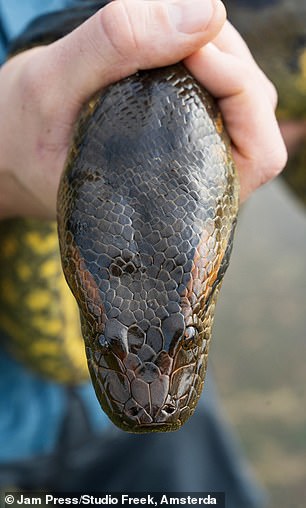Northern Green Anaconda: World Biggest Snake Discovered In The Amazon Rainforest
– The Northern Green Anaconda lives in the Amazon and is as thick as a car tyre
– Incredible footage shows a scientist swimming next to the enormous anaconda
The world’s largest snake has been discovered in the Amazon Rainforest – and at 26ft long and weighing 440lbs, it’s an absolute whopper.
The Northern Green Anaconda was found by TV wildlife presenter, Professor Freek Vonk, and is as thick as a car tyre.
Despite having a head the size of a human’s, it seems Professor Vonk, 40, wasn’t scared of getting up close and personal with the snake.
Incredible footage shows the Dutch biologist swimming next to the enormous anaconda.
Until now, only one species of Green Anaconda – also called the Giant Anaconda – has been recognised in the Amazon.
However, the Northern Green Anaconda has been confirmed as a distinct species in a new study, published in Diversity this month.
‘Together with 14 other scientists from nine countries, we discovered that the largest snake species in the world, the green anaconda,’ Professor Vonk said.
‘As we all know it from movies and stories about giant snakes – are actually two different species.
‘The green anacondas found in the north of their range in South America – including Venezuela, Suriname, and French Guiana – appear to belong to a completely different species.
‘Although they look almost identical at first glance, the genetic difference between the two is 5.5% and that is huge.
‘To put this in perspective, humans and chimpanzees are only genetically different from each other by about 2%.’
The researchers have given the new species the Latin name Eunectes akayima, which means the Northern Green Anaconda.
Despite only just being discovered, the researchers say that the new species is already under threat.
Professor Vonk explained: ‘The Amazon region is under severe pressure from climate change and continued deforestation.
‘Over a fifth of the Amazon has already disappeared, which is more than 30 times the area of the Netherlands.
‘The survival of these iconic giant snakes is inextricably linked to protecting their natural habitat.’
Professor Jesus Rivas, the lead author of the study, explained that he first realised there was more than one species of green anaconda over 15 years ago.
Along with his wife, Dr Sarah Corey-Rivas, they started to analyse samples to look for genetic differences.
However, it took until now to publish their findings.
Professor Rivas said: ‘Sarah and I started working on this in 2007 when we first noticed there was a big genetic difference between the Venezuelan samples and some samples from Peru.














Add Comment